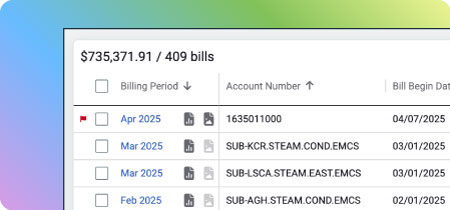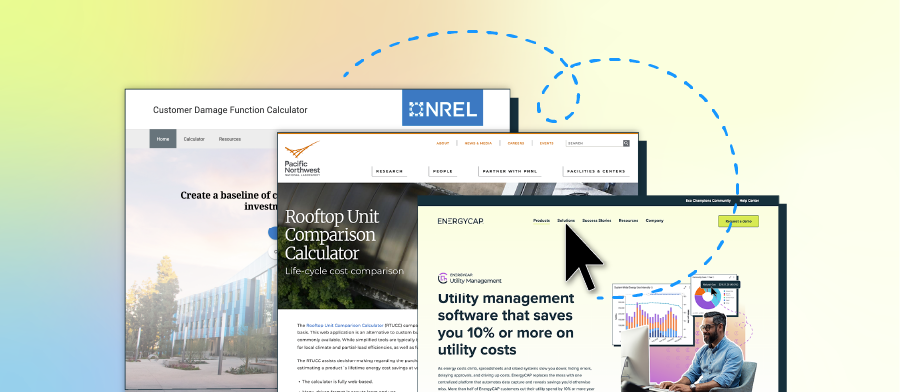Riverside County’s Process to Manage Utility Usage
Riverside County, CA was created on May 2, 1893 from parts of San Bernardino and San Diego Counties and, by land area, is the 26th largest county in the United States at 7,300 square miles. To serve such a large and diverse area, the County government maintains more than 1,800 facilities and is tasked with managing approximately 4,500 utility accounts across 57 different vendors. Staying on top of it all requires a high level of organization and teamwork amongst county staff, and when Janet Purchase signed on to be the county’s energy manager, she quickly recognized that the legacy utility bill management tools were not up to the task.
Piggybacking a recent bid by neighboring Orange County, Riverside was able to purchase an EnergyCAP Enterprise software license and prepared to quickly make it the center of their energy management program. The Great Recession delayed the implementation process, but once implementation got underway, good things started to happen. Today, Riverside County’s Energy Management and Accounting teams work together to assure energy and cost efficiency and can boast about a tremendous return on their EnergyCAP investment.
Riverside County Streamlines Utility Usage with a Proper Plan
When Janet Purchase signed on as Riverside County’s energy manager in 2008, she saw the potential for substantial energy and monetary savings. The utility bill processing workflow was largely manual, lacked thorough auditing and data validation, and required redundant bill entry into accounting and energy management applications.
The county’s legacy energy management software had been in place for several years without any updates. Functionality was limited, and the user interface was cumbersome, making it difficult to identify billing issues, or generate informative reports. Allocating energy use and cost among county agencies in shared facilities required a time-consuming analysis of complex spreadsheets. Janet stated, “We had multiple spreadsheets with multiple tabs, and we had a lot of conflicting information, especially in the general ledger codes. We had a lot of work to do to get our data right.”
In an environment of rapidly rising energy costs and a strong push for decreased fossil fuel consumption, Janet had her work cut out for her on the energy management side, as well. She needed to be able to identify inefficient county facilities, decrease energy consumption, expand use of renewable energy, and verify and quantify the success of her actions. And she had to do it all just as The Great Recession was getting underway worldwide.
The Solution
Years prior to going to work at Riverside County, Janet held the energy manager post at another California municipality, and while there, she implemented an energy management software application called FASER Energy Accounting. Janet recalled the functionality that FASER offered, including a large report library that made it easier to analyze data and share information. She knew that FASER had a successor named EnergyCAP, and she reached out to learn more about it.
EnergyCAP UtilityManagement’s functionality was vetted by Janet, then a one-person energy management operation, and she knew she wanted it to replace the county’s outdated application. Janet confirmed that the funds required to license and implement EnergyCAP UtilityManagement were available through as-of-yet unallocated county funds, but there were still county procurement requirements to be met. Fortunately, Orange County, CA had selected EnergyCAP via a public bid process just a few months earlier. Riverside County was able to piggyback Orange County’s bid and could move forward with the EnergyCAP purchase without the delays and costs associated with issuing their own RFP.
Riverside County was shopping for its energy and sustainability management solution in 2008, just as the full effects of The Great Recession were being felt nationwide. The recession officially began in July. Fannie Mae and Freddie Mac went bankrupt in August, and the stock market crashed in September, with the Dow Jones Industrial Average falling a then-record 777 points in one day. Congress approved the Troubled Assets Relief Program (TARF) in early October to bail out failing banks, and in February 2009, the American Recovery and Reinvestment Act (ARRA) was approved, injecting $787 billion into the economy via tax cuts, unemployment benefits, and $275 billion for “shovel-ready” public works projects.
The ARRA effectively ended the recession and was the start of numerous previously unexpected projects for Riverside County and many other U.S. municipalities. The county received a large ARRA grant from the Department of Energy. The Energy Efficiency and Conservation Block (EECBG) grant provided funding of $6,591,600 for a combination of strategic, energy-efficiency, and renewable energy projects. EnergyCAP UtilityManagement had been purchased, but Janet’s time was now dedicated to numerous other time-sensitive projects, delaying it’s implementation by nearly two years.
Process Improvement
In 2011, Janet, her recently expanded energy management staff, and a highly involved county accounting department, dedicated time to the implementation. Agreeing on a “one step at a time” approach, the team set its sights on improving the county’s bill processing workflow. The existing process included labor-intensive redundant data entry. Upon receipt, utility bills were hand-keyed separately into the energy management application and the PeopleSoft accounting system. Internal use and cost allocations were calculated in spreadsheets and then also manually entered into PeopleSoft. The team reviewed their process and, per Janet, saw “lots of opportunities for errors.”
County staff worked with the EnergyCAP team to implement a process that starts with EnergyCAP as the ‘smart front-end.’ Upon receipt, bills are entered into EnergyCAP UtilityManagement in batches, pass through a series of audits and, upon approval, are prepared for export to PeopleSoft for payment. When exported, approved bill files pass through an EnergyCAP-provided reformatter application to produce a file that is import-ready for PeopleSoft. The new process eliminated redundant data entry and assured that bills were audited and approved before being paid. When a bill fails an audit, a review is performed, the issue is resolved, and an alert is added to the bill record in EnergyCAP UtilityManagement. The alert is tracked for three months to confirm that the issue has been resolved. To date, the county has documented avoided costs of more than $490,000 as a result of the EnergyCAP UtilityManagement auditing process.
To further streamline the bill processing workflow, the Accounting team worked with the county’s largest service providers—Southern California Edison, AT&T, CR&R, and Waste Management—to obtain invoices electronically. Importing electronic bill files into EnergyCAP UtilityManagement reduced the number of manually-entered utility bills by 35%, increasing bill processing speed, while lowering labor costs and saving a lot of paper. Over a three-year period, the county documented bill processing savings of more than $115,000.
Recognizing that additional savings could be realized by eliminating manual utility bill entry completely, Janet and Accounting inquired about EnergyCAP’s database hosting service and Bill CAPture utility bill processing service. Purchasing EnergyCAP’s database hosting service provided the county with immediate access to updates, enabled them to license optional Report Designer application for custom report creation, and saved the county $6,700 per year versus on-premises hosting costs.
With the Bill CAPture and hosting services in place, the county’s non-electronic invoices are scanned and uploaded in PDF format, where they are transformed via an optical character recognition (OCR) process for import into EnergyCAP. A PDF image of the actual bill is also attached to the bill record in EnergyCAP UtilityManagement for quick access. Today, the county’s cost to process one utility bill has been reduced from an average of $5.21/bill to just $1.70/bill, for an annual savings of $48,488.
Solar Savings for Debt Service
While streamlining the utility bill processing workflow, Janet was also busy managing a countywide solar installation project. The 12 MW project included solar installations at 14 different sites with a budget of greater than $55 million.
County regulations required that project costs must be covered by energy cost savings. Given that, Janet’s team had to develop a process to quantify and report revenue generated through the solar projects. Three revenue sources were identified and implemented:
- California Solar Initiative Rebates: Monthly incentive payments to the county, with a lump-sum payment at the end of the 24-month period. Rebate amounts were based on the performance of the solar system.
- Net Metering Sites: Revenue is calculated by multiplying the monthly generation (kWh) by the contract blended rate for the appropriate utility vendor.
- Renewable Energy Self-Generation-Bill Credit Transfer (RES-BCT): The dollar value of solar energy generated at one site can be transferred to other SoCal Edison accounts.
By using designated info-only fields (data is not transferred to Accounting), the county is able to track and report on the latter two revenue sources in EnergyCAP UtilityManagement.
A solar installation that generates more energy than it consumes is designated a “Generating Account.” The excess energy value (in dollars) is then transferred to other facilities, labeled “Benefitting Accounts,” on a percentage basis. At the end of each month, county staff initiate the bill split processor in EnergyCAP UtilityManagement to calculate and allocate the actual solar savings for each facility.
EnergyCAP ROI
The steps taken by Janet, her staff, and the Accounting team at Riverside County have, since 2012, resulted in documented savings, to-date, of more than $710,000.
How Utility Bill Management Leads to Savings and Efficiency
In 2008, Janet Purchase inherited a highly manual utility bill workflow process and an outdated energy management software application. Through skill, ingenuity, and interdepartmental teamwork, the staff at Riverside County have been able to revamp the county’s entire energy management program, and EnergyCAP is at the core of that program.
Janet commented:





![Top 12 sustainability reporting platforms (ESG) [2026]](https://www.energycap.com/wp-content/uploads/2025/12/blog_article_top-sustainability-platforms.webp)






